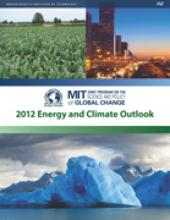MIT News Story: Growing population will increase global climate challenges
As the world grows to a projected total population of 10 billion, it also faces immense environmental challenges: climate change, food and energy security, water scarcity, ecosystem protection and the problems that come with urbanization. Any projection of the future is full of uncertainty. But to better understand how decisions made today will affect the future, we need to also better understand the interconnections between human activities and environmental change.
Supplemental data for the Outlook includes a detailed set of projections through the year 2050 for each of 16 major regions of the world. We provide this numerical data in the hopes that researchers and policymakers will find them useful for their own analyses.
Download: Outlook 2012 data tables
Using a projection modeling system (MIT’s Integrated Global System Model), the 2012 Energy and Climate Outlook examines the world’s current development path and seeks to determine the associated energy, climate, atmosphere, ocean and land-use implications. It also incorporates emissions targets G20 nations made at a 2009 UN meeting (i.e., Copenhagen pledges) to reduce greenhouse gas emissions by 2020. The objective is to show how far the 2020 pledges take us, and what is at risk if we fail to push beyond these emissions reduction goals. These findings are a projection – not a prediction, as it is within our power as a society to change the current path if we do not like its implications.
Key Findings:
- The Copenhagen pledges will nearly stabilize emissions in the developed countries, but global emissions will continue to grow rapidly.
- Global change will accelerate with changes in global and regional temperatures, precipitation and land use, and the world’s oceans will warm and acidify.
- Population and income growth will fuel a significant rise in the motorized vehicle fleet and increase CO2 and other pollutant emissions, especially in developing regions.
- While further emissions cuts in developed countries would be useful, such cuts will have less impact on global emissions over time.
- The Copenhagen pledges begin a transition to alternative energy in developed countries and China, but they do not provide enough incentive to create the full transformation needed within the energy system (i.e., wide-scale adoption of renewables, carbon capture and storage, nuclear or alternative propulsion systems in vehicles) to avert dangerous levels of climate change.
- While emissions from fossil fuels are sizeable, other greenhouse gas and land use emissions are also important and cannot be ignored if more stringent stabilization and temperature goals are to be achieved. Reductions in these emissions are often the most cost-effective. If policies to reduce them fail, a major opportunity to limit climate change may be missed.


